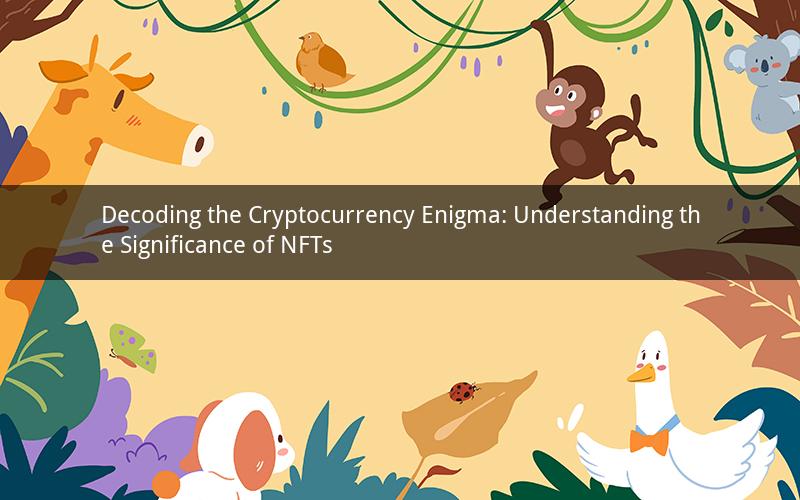
Introduction:
The world of cryptocurrencies has expanded exponentially over the past decade, captivating investors, artists, and enthusiasts alike. Amidst this digital revolution, a term that has gained significant attention is NFT. This article delves into the essence of NFTs, exploring their meaning, significance, and impact on the cryptocurrency landscape.
Section 1: Defining NFT
NFT stands for Non-Fungible Token, which is a digital asset that cannot be replaced or exchanged on a one-to-one basis with another token. Unlike cryptocurrencies like Bitcoin or Ethereum, which are fungible and can be interchanged, NFTs possess unique qualities that make them one-of-a-kind.
Section 2: The Birth of NFTs
The concept of NFTs originated in the early 2010s, but it gained traction with the rise of the blockchain technology. Digital artists and creators found a new medium to showcase their work by leveraging the blockchain's ability to authenticate and verify ownership of digital assets.
Section 3: Characteristics of NFTs
NFTs possess several distinctive features that set them apart from other digital assets:
1. Uniqueness: Each NFT is unique, and its value is derived from its rarity and ownership history.
2. Authenticity: The blockchain ledger ensures the authenticity of an NFT, as it cannot be counterfeited or altered.
3. Ownership: The blockchain ledger maintains a transparent record of an NFT's ownership, making it easier to prove provenance.
4. Transferability: NFTs can be transferred between owners through a secure and transparent process.
Section 4: Use Cases of NFTs
NFTs have found various applications in the digital realm, including:
1. Digital Art: Digital artists use NFTs to tokenize their work, allowing collectors to own a piece of art that can be stored in a digital wallet.
2. Collectibles: Sports memorabilia, virtual collectibles, and gaming items are often minted as NFTs, providing a new avenue for enthusiasts to own and trade unique digital assets.
3. Music and Entertainment: Musicians, filmmakers, and other content creators use NFTs to tokenize their work and gain direct access to their fanbase.
4. Real Estate: The real estate industry has begun exploring the use of NFTs to tokenize properties, making transactions more secure and transparent.
Section 5: The Impact of NFTs on the Cryptocurrency Landscape
The rise of NFTs has had a profound impact on the cryptocurrency landscape, prompting the following effects:
1. Increased Interest in Blockchain Technology: NFTs have sparked renewed interest in blockchain technology, as more individuals and businesses explore its potential applications.
2. Enhanced Security: The use of NFTs has bolstered the security of digital assets, as the blockchain ledger provides a robust and transparent platform for verifying ownership.
3. Expansion of Market Opportunities: The NFT market has created new opportunities for artists, creators, and investors, allowing them to monetize their digital creations and assets.
Section 6: Frequently Asked Questions about NFTs in Cryptocurrency
Question 1: What makes NFTs different from cryptocurrencies?
Answer 1: NFTs are non-fungible tokens, meaning they cannot be exchanged on a one-to-one basis with other tokens. Cryptocurrencies like Bitcoin and Ethereum are fungible, allowing for seamless exchange.
Question 2: Can NFTs be copied or duplicated?
Answer 2: No, NFTs cannot be copied or duplicated due to their unique digital fingerprint and the blockchain ledger's ability to verify ownership.
Question 3: Are NFTs a good investment?
Answer 3: As with any investment, the value of NFTs can fluctuate. It's essential to conduct thorough research and consider the potential risks before investing in NFTs.
Question 4: How do NFTs contribute to the digital art market?
Answer 4: NFTs provide a new platform for digital artists to showcase their work and gain direct access to a global audience, fostering innovation and growth within the digital art market.
Question 5: Can NFTs be used for real estate transactions?
Answer 5: Yes, NFTs can be used to tokenize real estate properties, providing a more secure and transparent transaction process, and potentially reducing the costs associated with traditional real estate transactions.
Conclusion:
NFTs have emerged as a transformative force in the cryptocurrency landscape, offering unique and innovative solutions for artists, creators, and investors. As the technology continues to evolve, the potential applications of NFTs in various industries are boundless, paving the way for a new era of digital ownership and creativity.